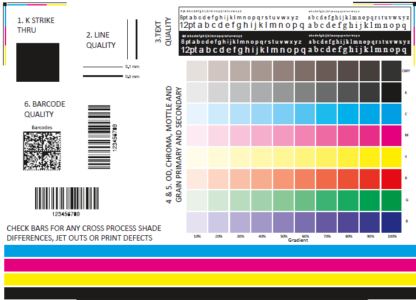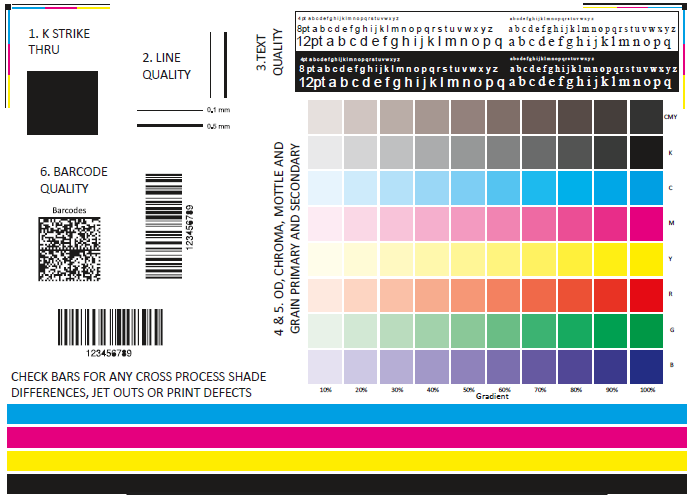Companies evaluating paper for suitability for their inkjet environment have different expectations. At a minimum, a paper has to be compatible with the device, but the relative importance of quality measures will vary. What is most important to you and your customers: gamut, show-through, small text clarity, mottle, coalescence, edge clarity, or are they all important? The answers to these questions on print quality priorities generally vary by market segment.
- Transactional print mostly focuses on show through and small text clarity, but when corporate color matching is required, gamut comes into play.
- Gamut, mottle, coalescence and text clarity are always important measures for direct mail quality.
- Many commercial segments have a higher standard for all areas of print quality than transaction and most direct mail.

Use Measurable Images for Print Quality Testing
What does it mean to measure print quality?
For inkjet, quality does not have a defined standard, but experience has shown that there is a minimum achievable range of performance needed on the papers used in each market. Since paper highly impacts print quality, choosing or comparing paper for your inkjet device should not be subjective, but driven by the data.
Inkjet manufacturers provide lists of “qualified” papers. To qualify for this list, a paper must successfully print a standardized test pattern with a defined ink volume at rated production speed. A test typically runs for at least 2000 lineal feet and must be dry at the end of the run with no visual wrinkles. This test process is about ink, machine and paper compatibility. The key here, is not to mess up the inside of the press with roller contamination and web breaks from wet output.
Once the printed output has passed this first step, the output is checked for color to color bleed, coalescence and mottle. If the output is visually unappealing, the paper is normally rejected unless color saturation, mottle and coalescence can be minimized by adjusting settings.
This may be all that is done for a paper to be “qualified.” This tells you that the paper will run, but not the quality you can expect. Often an OEM is also performing a measured print quality analysis on listed papers, but this information is not normally shared with the OEM’s customers.
Does qualified mean quality?
Without measurement data, it’s hard to know if your print expectations align with the person qualifying the paper. The OEM is supporting customers in many market segments, what is acceptable to one may not be acceptable to another. This subjective approach can lead to surprises and disappointment if a “qualified paper” does not meet the customer’s print quality expectations.
Without an agreed upon standard for inkjet quality, it’s hard for OEMs to qualify papers in an objectively meaningful way. Many categorize paper as 1-4 or with a star ranking. These categories or rankings bundle all of the aspects of print quality into a single, averaged measure. This means that two papers with the same ranking might produce very different results. One might have scored high on text clarity and low on gamut – or vice versa. A paper that was not suitable for full color inkjet might be great for mono applications like books or forms. Even with the top “score” how do you know if this paper is right for your environment?
You are the decider on what quality means
Without an industry standard for print quality, you need to determine which quality measures are most important to you and your customers. Keep in mind that these priorities may vary by customer or type of work. Here are the key items to test and measure:
- Optical density
- Chroma – CMYKRGB
- Show through
- Color gamut
- Mottle
- Coalescence
- Color to color bleed
- Small text clarity
- Edge clarity
At Inkjet Insight, we call these Key Performance Indicators (KPIs) for print quality. We have evaluated and profiled 100’s of papers and have drilled down within various paper categories the data ranges which they fall. This creates a valuable reference point during your evaluation period to evaluate within a target based on ISO measurements.
Do you feel the current paper qualification and ranking from your OEM is clear enough to make the right paper choices, or should data from print quality measurements be available for you to make a clear and informed decision? Get in touch or leave a comment. You can also participate in our latest research on paper testing by taking this short survey on satisfaction with current paper testing processes.

